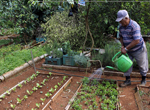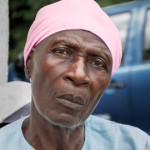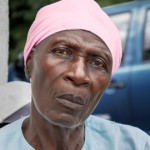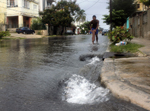Cuba Safeguards Biodiversity to Guarantee Food Supplies | Cuba busca garantizar alimentos bajo otro clima
Cuba seeks to guarantee food supplies in changing climate
By Ivet González, with reporting by Patricia Grogg
IPS
English | Spanish
Havana, Cuba — In the face of the challenge of producing more food in a changing climate, farmers in Cuba are coming up with alternatives like planting drought-resistant crops and digging ponds to guarantee water supplies, in order to keep food on the table during times of drought, heavy rains or hurricanes.

Pinar del Río has recently been hit by several hurricanes, which are becoming more intense as a result of climate change (Credit: Ivet González/IPS).

Some 30 varieties of beans collected by a farmer taking part in the Programme for Local Agrarian Innovation (Credit: Ivet González/IPS).
Rafael González, a small farmer with the Ignacio Pérez Rivas Credit and Services Cooperative, told IPS that
“when drought comes, we have vegetables and fruit that adapt to dry conditions, and if a storm hits, we have other varieties that are resistant to that as well.”
When the June through November hurricane season is approaching, González, from the municipality of Manicaragua in the mountains of Escambray, recommends
“having fruit trees like tamarind and guava, orchards with different sizes of plantain and banana, and vegetables like sweet potato, squash, yams and malanga (related to the taro root), which are resistant to wind and rain.”
In this area in the province of Villa Clara, 270 km from Havana,
“we have crops like guava, avocado and orange, which adapt to drought conditions,”
said González, a local defender of biodiversity. Another of the strategies followed by the more than 120 farmers in his cooperative involves
“returning to the crops traditionally grown in this area.”
Studies on seed improvement, which agricultural research centres in Cuba began to carry out in the late 1980s, have borne fruit in adverse climate conditions and helped boost food production.
Small farmers like González are involved in developing improved seeds, to obtain good harvests in difficult environmental conditions. These efforts are backed by the Programme for Local Agrarian Innovation (PIAL), which has benefited some 50,000 farmers, with the support of international development aid.
Since 2007, one of the priorities of the Cuban government has been to bring about the changes needed to increase agricultural productivity and output and reduce imports. In 2011, Cuba spent 1.5 billion dollars on imports to feed the population of 11.2 million. Adapting to global warming is another challenge faced by agriculture.
Farmers like Esther Caballero are feeling the extreme effects of climate change.
“There is severe drought in some periods, and in other parts of the year it rains a lot,”
the farmer from Jibacoa, a town in Manicaragua, told IPS.
In the second half of the 20th century, average annual temperatures have gone up 0.5 degrees in Cuba, and the frequency of heavy rains, storms and severe local drought has increased, according to the 2008 study “The Caribbean and Climate Change: The Costs of Inaction”, carried out by academics at Tufts University near Boston.
Although it is not yet clear whether the number of hurricanes in the Caribbean will increase, they will become more intense, said meteorologist José Rubiera. Storms
“will be around 12 percent rainier for each Celsius degree of temperature increase,”
he says in an article on the reduction of risks by means of adaptation strategies, to which IPS had access.
A study by the Economic Commission for Latin America and the Caribbean (ECLAC), “Climate Change and Development in Latin America and the Caribbean: Overview 2009”, says that
“Historically, agriculture has been able to adapt to gradual climate changes, but extreme weather events pose a great threat to the sector.”
That will further undermine food security in the countries of Latin America and the Caribbean, the report says.
Cubans already saw local food supplies dwindle in 2008 when the country was hit by three devastating hurricanes: Gustav, Ike and Paloma, which set off alarm bells with respect to the huge impact of weather events and caused 10 billion dollars in economic losses – the worst in the history of Cuba.
Two of the hurricanes that summer hit Pinar del Río, 157 km from Havana. Researcher Carlos Lopetegui told IPS that
“not a single plantain plantation was left in the province.”
But thanks to a “crop biofactory”, seeds were immediately obtained to plant again, he said.
The biofactory, an initiative of the Programme of Local Support for the Modernisation of Agriculture (PALMA) in Cuba, makes it possible to quickly replace crops that have been destroyed by an extreme weather event, said Lopetegui, general coordinator of the project in that province.
PALMA began to operate in 2009 with funding from the European Union, with the aim of increasing food production. The programme’s broad strategy includes a focus on sustainable agroecological production and climate change adaptation measures like the efficient use of water, said Maruchi Alonso, the national head of the programme.
“Pinar del Río is exposed to lengthy periods of drought. Generally, these periods end when a hurricane hits – in other words, the province goes from one extreme event to another,” Lopetegui said.
In 2011, Pinar del Río lost some 1,350 hectares of rice, a staple of the Cuban diet, to drought.
One of the main benefits offered by PALMA is the provision of irrigation systems to farmers. Before the systems are installed, the specific water supply conditions are studied in each area, to guarantee efficient use of water during the November to April dry season.
In mountainous areas in Pinar del Río, like Puerto Escondido in the municipality of La Palma, artificial ponds decorate the small farms. But their real aim is to store up water against the dry season. The most well-off farmers cover the cost of renting bulldozers to dig deeper holes for the ponds.
Some also set up wind mills to help water the crops.
“Almost everyone is trying to get one,”
Roiber Pimentel, a young local agronomist, told IPS as he took his oxen to drink at his small pond.
Source: IPS
Cuba busca garantizar alimentos bajo otro clima
Por Ivet González, con aportes de Patricia Grogg
IPS
inglés | español
La Habana, Cuba — Ante el desafío de producir más alimentos en un clima cambiante, agricultores de Cuba diseñan alternativas como sembrar variedades resistentes y garantizar el abastecimiento de agua para llenar las mesas familiares durante tiempos secos, de huracanes o lluvias.

Pinar del Río recibió en los últimos tiempos el embate de numeroso ciclones, que tienden a ser más intensos por el cambio climático (Crédito: Ivet González/IPS).

Alrededor de 30 variedades de frijoles recogidan por un agricultor que participa en el Programa para la Innovación Agraria Local (Crédito: Ivet González / IPS).
Defensor de la biodiversidad, el campesino Rafael González, de la Cooperativa de Créditos y Servicios Ignacio Pérez Rivas, aseguró a IPS que, “si viene la sequía, tenemos viandas y frutas que se adaptan a esas condiciones, y si viene un temporal, contamos con otras variedades para ese período”.
Cuando se acerca la temporada de huracanes, este productor del municipio de Manicaragua, en las montañas del Escambray, aconseja “tener árboles de frutas como el tamarindo y la guayaba, plantaciones de plátanos de varios tamaños y viandas como el boniato, la calabaza, el ñame y la malanga, que resisten los vientos y las lluvias”.
En esta localidad de la provincia de Villa Clara, a 268 kilómetros de La Habana, tenemos cultivos como la “guayaba, el aguacate y la naranja, que se adaptan a la sequía”, indicó González. Otra de las estrategias de los más de 120 agricultores de su cooperativa consiste en “volver a los cultivos tradicionales de la zona”.
Por su importancia para elevar la producción de alimentos, centros de investigación agrícola en Cuba impulsaron desde fines de los años 80 los primeros estudios sobre mejoramiento de semillas que rindieran frutos en condiciones climáticas adversas. Hoy constituye un rubro de casi todas las instituciones de este tipo en el país.
Una parte del campesinado logra su propio set de semillas para obtener buenas cosechas en condiciones ambientales difíciles. Esta iniciativa la impulsan proyectos como al que pertenece González, el Programa de Innovación Agrícola Local, que con apoyo de la cooperación internacional ha beneficiado a unas 50.000 personas.
La adaptación de la agricultura al recalentamiento global se suma a otros retos del sector, sujeto a transformaciones desde 2007 para mejorar la productividad y sustituir importaciones. Cuba gastó en 2011 alrededor de 1.500 millones de dólares en la importación de alimentos para los 11,2 millones de habitantes del país.
Mientras, los cambios extremos del clima son visibles para gente del campo como Esther Caballero. “Hay mucha sequía en algunos períodos y en otros llueve mucho”, comentó a IPS esta agricultora de Jibacoa, un pueblo de Manicaragua.
Durante la segunda mitad del siglo XX, la temperatura anual promedio del aire en Cuba subió 0,5 grados y aumentó la frecuencia de fuertes lluvias, tormentas y sequías locales severas, según el informe titulado “El Caribe y el cambio climático. Los costos de la inacción” realizado en 2008 por la Universidad estadounidense de Tufts.
Se desconoce si aumentará el número de ciclones en el Caribe, apunta el meteorólogo José Rubiera, pero sí tenderán a ser más intensos. “Serían alrededor de 12 por ciento más lluviosos por cada grado de incremento en la temperatura”, prevé el experto en un artículo entregado a IPS sobre la reducción del riesgo mediante una estrategia de adaptación.
Un estudio de la Comisión Económica para América Latina y el Caribe indicó en 2009 que, “históricamente, la agricultura ha podido adaptarse a los cambios paulatinos del clima, pero los fenómenos extremos representan una gran amenaza para este sector”. Por ello, se tornará más adversa la seguridad alimentaria de países caribeños y del resto de América Latina.
Ya la población cubana vio languidecer su canasta básica en 2008 por tres devastadores huracanes, que encendieron la alarma sobre el posible gran impacto de fenómenos meteorológicos. Gustav, Ike y Paloma dejaron las afectaciones económicas más grandes de la historia del país, estimadas en 10.000 millones de dólares.
Dos de estos meteoros azotaron entonces al territorio de Pinar del Río, a 157 kilómetros de La Habana. De esos difíciles días, el investigador Carlos Lopetegui recordó a IPS que “no quedó un platanar en la provincia”. Gracias a la disponibilidad de una biofábrica, abundó, se obtuvieron aceleradamente semillas para recuperar el cultivo.
Esa iniciativa, uno de los rubros del Programa de Apoyo Local a la Modernización del sector Agropecuario (Palma), permite, “cuando haya un evento extremo, suplir la necesidad de una producción rápida en caso de quedarse sin plantaciones”, detalló Lopetegui, coordinador general del proyecto en esa provincia.
El Palma arrancó en 2009 con financiamiento de la Unión Europea para capitalizar el sector agropecuario y producir más alimentos. Aunque resulta muy abarcador, incluye un enfoque agroecológico sostenible y acciones de adaptación al cambio climático como el uso eficiente del agua, señaló Maruchi Alonso, su coordinadora nacional.
“Pinar del Río está expuesta a prolongados períodos de sequía. Por lo general, la ruptura de estos ha sido un ciclón, es decir, se va de un evento extremo a otro”, puntualizó Lopetegui. A causa de la sequía, Pinar del Río perdió en 2011 unas 1.354 hectáreas de arroz, un alimento básico en la dieta cubana.
Uno de los principales beneficios del Palma para el territorio consiste en la entrega de sistemas de riego a productores. Antes de instalarlos, se analizan “las condiciones específicas de las fuentes de abasto para hacer un uso eficiente del recurso hídrico” de cara al período poco lluvioso que abarca de noviembre a abril.
En asentamientos montañosos pinareños, como el de Puerto Escondido en el municipio de La Palma, lagunas artificiales parecen adornar las parcelas. Pero cumplen el objetivo de almacenar agua durante la etapa lluviosa. Agricultores con más recursos asumen el costo del alquilar una excavadora para hacer un hueco más hondo.
Hay quien logra colocar una turbina y así regar con más facilidad sus plantaciones. “Casi todo el mundo intenta tener una”, indicó a IPS el joven ingeniero agrónomo de esa comunidad Roiber Pimentel, mientras abreva a sus bueyes en su pequeño lago, fruto de la tradición local para guardar el tan escaso recurso.
Fuente: IPS








Comments
Cuba Safeguards Biodiversity to Guarantee Food Supplies | Cuba busca garantizar alimentos bajo otro clima — No Comments